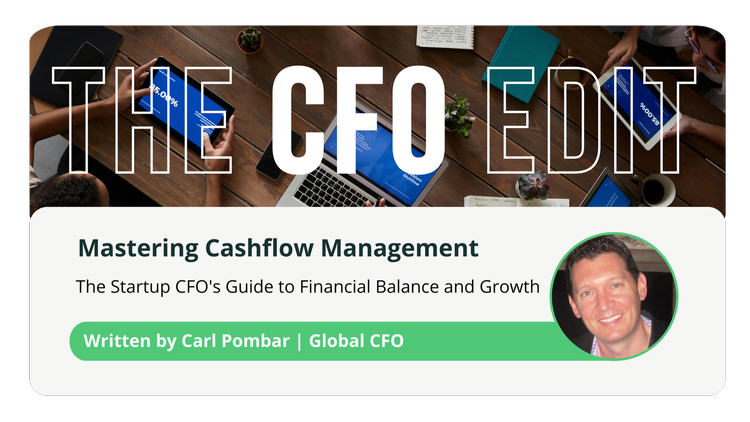
The CFO Edit | Mastering Cashflow Management
24 Jan, 202510 Minutes
Cash flow management is one of the more important aspects of any CFO’s role, especially with earlier-stage/VC-backed companies, and even mid-stage PE-backed portfolio companies. Cashflow management involves understanding your cash situation at all times – from tracking and optimizing current cash inflows/outflows, projecting future cash flows, understanding your “runway,” to ensuring you have sufficient cash flow to take advantage of growth opportunities, be it the right hire, the right acquisition or the needed product launch, and ultimately achieve positive cash flow.
Why Cash Flow Management is Important
There are a number of reasons you want to understand this concept well and why it’s so important - getting cash flow management correct is critical for all stakeholders. The Board of Directors and CEO want to know when the runway ends (when you run out of cash) so they know how far in advance to start fundraising and to ensure the business's cash flow is sufficient to seize growth opportunities. Employees, of course, want to be sure they’ll be getting paid. Investors want to know the financial health of the company. Lenders will also want to see the runway, will have covenants and reporting requirements around cash projections, and want to see when those covenants may be at risk of being violated.

Mastering Current Cash Flows
The foundational elements of a solid cash flow plan start with ensuring you have clean, reliable data and that you fully understand all cash inflows and cash outflows, not missing out on any material items. This can be done by looking at your AP register, payroll register, capex accounts, debt schedules, etc. Once you’re sure you’re accounting for all existing, and projected cash flows, you’ll need to determine the timing of these payments – the second key element. Use historical payment terms for both A/R and A/P to get a sense of timing. One example I often sit down with my Go-to-Market head to discuss is the projected new headcount, as high-growth sales-led organizations are frequently hiring. Large Capex budget items are another common budget expense.
Building Reliable Cash Flow Projections
Once you have clean, reliable historical and current cash flows, the next key component of managing cash flow is modeling cash projections. I’ve spent a lot of time in the trenches at SaaS businesses, and as a simple example, you’ll want to clearly understand how bookings turn to revenue (and when), and when revenue turns to cash. In building out cashflow projections you’ll obviously have to work with the management team to get their respective budgets. You’ll need to understand the nuances of the business to understand the timing of the issues I mentioned above (i.e. when does revenue turn to cash, when do we typically pay invoices, when do customers typically pay us, etc).
The CFO needs to lead this communication and make sure the correct financial processes, procedures, and controls are in place, so the company knows exactly what the actual financials are each month but also constantly updating/maintaining reliable projections. Remember, even though financials are typically updated monthly, often cash flow analysis will be done on a daily/weekly basis so that analysis will need to be maintained accordingly.

Profit ≠ Cash Flow
Another important concept to understand in cash flow management is that profits don’t equal cash flow. It's also important to understand that negative cash flow can occur even when a business is profitable, due to, among other things, non-cash expenses as well as timing differences with income and expenses. I won’t assume this is basic Cash Flow 101 and will briefly share my point here. Under the accrual/indirect method, Net Income is the starting point for the cash flow statement, where we then add back non-cash expenses that were on the income statement and then adjust for changes in working capital and related items.
By way of example, we may have net losses on the income statement of -$1,000, but if we “add-back” the $1,000 non-cash depreciation expenses we expensed on the income statement to reconcile to cash, we could be left with $0 cash breakeven. To take this a step further, if changes in cash from the balance sheet working capital items (A/R, A/P, Inventory, etc) are then added to, say, negative $1,000 then you’d have true cash net losses of -$2,000, a more dire situation than you expected. Under a direct/cash method analysis, non-cash items (like D&A) never come into play, so there are no adjustments to be made as we’re working only with true cash items.
Adjusting Cash Flows for Better Outcomes
Once you’re sure you have reliable actual financials and can confidently forecast cash flows over whatever frequency you’d like – weekly, monthly, even daily, if need be, then you can take that information, decide where any issues are, and determine strategies to take action. Identifying and addressing cash flow problems early can prevent more significant financial issues down the line.
Three of the more common ways to address change in cash flow management relate to the three main working capital accounts, namely;
How to delay (“improve,” we say) Accounts Payables
How to collect/turn Accounts Receivables faster and
How to turn Inventory faster (some rare occasions when you may not want to turn inventory faster, but typically you’d want to).
Extending payables even 1-week, or better, negotiating with vendors to extend 15 or 30 days acts as a form of short-term financing to the company. The same concept applies to the other side of the business – collecting receivables faster means bringing in cash sooner. On the inventory side, optimizing inventory through things like just-in-time inventory also acts as a form of short-term financing. All these strategies can be affected through things like early-pay or full-pay discounts, providing various payment options, negotiating better with suppliers, and monitoring for potential bad debt (customer credit). For example, you can sometimes save money by paying invoices early or conversely, you could get clients to pay early by offering a discount.

Frequency of Cash Flow Analysis
I often get asked how often a CFO should conduct cash flow analysis. Regular updates to cash flow analysis are essential for maintaining a healthy cash flow, being ready to seize those growth opportunities, and ensuring the business can meet its financial obligations. Depending on the situation, I’ll often update and re-analyze cash flow projections daily or weekly. Daily may sound like overkill, but I’ve worked for companies where they are truly managing cash on a day-to-day basis (not ideal). These are often industries where long payment cycles are the norm (i.e. healthcare) or for earlier-stage startups who are still trying to get to a more mature and stable business cycle. As CFO, you need to do what works best for you and the company. I tend to prioritize more frequent updates to cash flow analysis rather than less frequent ones.
The Right Tools for Cash Flow Management
In terms of tools to assist in cash flow management, we need to differentiate between day-to-day cash flow management and modeling future cash flow projections.
In terms of day-to-day tools, there are many on the market to assist with A/R collections, A/P payments, Inventory management, Revenue Cycle Management, etc. I’ll leave out specific names, to not seem like I’m endorsing certain products, but a lot of these “fintech” tools have made the life of a CFO more efficient.
On the other hand, in terms of cash flow projections, call me old-school, but I grew up on Excel and still use Excel for all financial modeling (budgeting/projections). I know various tools on the market claim to also help with this area of modeling, and this may be true, but I’ve found that every company is unique, and you could spend more time trying to fit a square peg into a round hole with some off-the-shelf tools. No doubt AI will provide exponentially better tools for this, but my sense with AI is we’re close, just not quite there yet.
When to Start Cash Flow Analysis
I’m also often asked when to start thinking about cashflow management and I always say it’s never too early. I start this process from Day 1. Getting into “good” cash flow management habits from the start will go a long way later. And by “good” I mean formal processes including written policies for things like customer credit, A/R, and A/P terms, forms of acceptable payment, frequent communication with relevant stakeholders, keeping clean data (updating actuals and re-forecasting projections as needed), and holding people accountable for effecting change.
Further, all these suggestions apply to any company at any stage. Clearly, a public Fortune 500 company will have a more involved process and model as well as additional “solutions” – meaning easier and more options for capital including loans, bonds, and equity, but the importance of this analysis is equally as important at any business stage, just at different scales.

Re-active vs Pro-active Cash Flow Management
One other item I wanted to address was when cashflow management gets “next level” involved, meaning you move beyond the VC (even PE) focused “runway” approach, which I’ll call a more “re-active” approach and start to analyze spending money on growth opportunities, which I’ll call a “pro-active” approach. This is to say, moving from a “will we have enough money to survive” approach to a “we have plenty of money for now, so can we make this acquisition and still have enough cash 2 years from now” approach.
The latter analysis is not only a psychologically different analysis for CFOs but a different view of analysis looking at things like accretion to cash flow, ROIs of an investment, opportunity costs, etc. This topic gets involved and is also for another time, but I did want to mention this.
Avoiding Common Cash Flow Pitfalls
Lastly, I wanted to share my view on the most common mistakes made by companies in trying to manage cash flows – I’ve been deeply involved with various and numerous clients when it comes to cash flow, so I can speak from experience. Here are the top three mistakes to avoid:
Being unrealistic – either about revenue, expense projections, or the timing of cash flows. Companies tend to be too aggressive rather than conservative enough in their forecasts, which can lead to surprises down the road.
Not implementing cash flow improvement strategies – such as extending payables or turning inventory faster – because of fear of losing customers. If you have a great product, you likely have more leverage with your customers than you think. When approached correctly, conversations with customers or vendors about working capital terms are often successful.
Waiting too long to raise additional capital – Capital raising, unfortunately, can almost become a full-time job (don’t let it be). It always takes longer to raise and structure new capital than expected, so getting ahead of the process is crucial.
In Conclusion: Cash Flow as a Strategic Priority
In summary, cash flow management is one of the critical responsibilities of any CFO. Whether it’s during tight times and having to understand the company’s runway, or during bright times and being ready to seize a growth opportunity. Make sure you focus on clean historical actuals, reliable projections, and your three areas of adjustments/active management, and remember profits don’t equal cash flow, there are certain tools in the market to assist you, and it’s never too early or too small to start this analysis.



